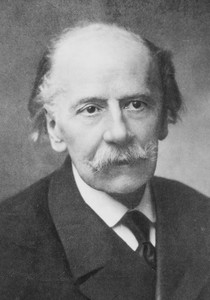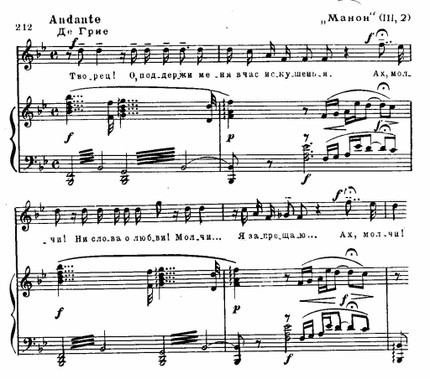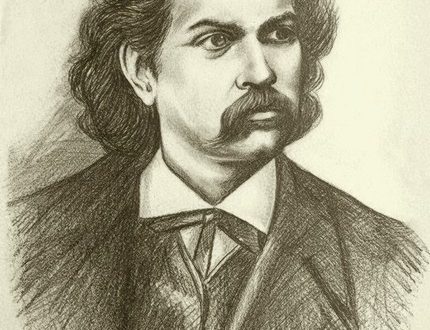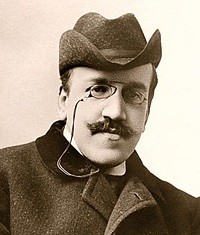
Jules Massenet |
Contents
Jules Massenet
Massenet. Elegy (F. Chaliapin / 1931)
Never did M. Massenet show as well as in “Werther” the enchanting qualities of the talent that made him a musical historian of the female soul. C. Debussy
Oh how nauseated Massenet!!! And what is most annoying of all is that in this nausea I feel something related to me. P. Tchaikovsky
Debussy surprised me by defending this confection (Massenet’s Manon). I. Stravinsky
Every French musician has a bit of Massenet in his heart, just as every Italian has a bit of Verdi and Puccini. F. Poulenc

Differing opinions of contemporaries! They contain not only a struggle of tastes and aspirations, but also the ambiguity of J. Massenet’s work. The main advantage of his music is in the melodies, which, according to the composer A. Bruno, “you will recognize among thousands”. Most often they are closely connected with the word, hence their extraordinary flexibility and expressiveness. The line between melody and recitative is almost imperceptible, and therefore Massenet’s opera scenes are not divided into closed numbers and “service” episodes connecting them, as was the case with his predecessors – Ch. Gounod, A. Thomas, F. Halevi. The requirements of cross-cutting action, musical realism were the actual requirements of the era. Massenet embodied them in a very French way, in many ways resurrecting traditions dating back to J. B. Lully. However, Massenet’s recitation is based not on the solemn, slightly pompous recitation of tragic actors, but on the artless everyday speech of a simple person. This is the main strength and originality of Massenet’s lyrics, this is also the reason for his failures when he turned to the tragedy of the classical type (“The Sid” according to P. Corneille). A born lyricist, a singer of intimate movements of the soul, able to give special poetry to female images, he often takes on the tragic and pompous plots of the “big” opera. The theater of the Opera Comique is not enough for him, he must also reign in the Grand Opera, for which he makes almost Meyerbeerian efforts. So, at a concert from the music of various composers, Massenet, secretly from his colleagues, adds a large brass band to his score and, deafening the audience, turns out to be the hero of the day. Massenet anticipates some of the achievements of C. Debussy and M. Ravel (recitative style in opera, chord highlights, stylization of early French music), but, working in parallel with them, still remains within the aesthetics of the XNUMXth century.
Massenet’s musical career began with his admission to the conservatory at the age of ten. Soon the family moves to Chambéry, but Jules cannot do without Paris and runs away from home twice. Only the second attempt was successful, but the fourteen-year-old boy knew all the unsettled life of the artistic bohemia described in Scenes … by A. Murger (whom he knew personally, as well as the prototypes of Schoenard and Musetta). Having overcome years of poverty, as a result of hard work, Massenet achieves the Great Rome Prize, which gave him the right to a four-year trip to Italy. From abroad, he returns in 1866 with two francs in his pocket and with a piano student, who then becomes his wife. Further biography of Massenet is a continuous chain of ever-increasing successes. In 1867, his first opera, The Great Aunt, was staged, a year later he got a permanent publisher, and his orchestral suites were a success. And then Massenet created more and more mature and significant works: the operas Don Cesar de Bazan (1872), The King of Lahore (1877), the oratorio-opera Mary Magdalene (1873), music for the Erinyes by C. Leconte de Lily (1873) with the famous “Elegy”, the melody of which appeared as early as 1866 as one of the Ten Piano Pieces – Massenet’s first published work. In 1878, Massenet became a professor at the Paris Conservatory and was elected a member of the Institute of France. He is in the center of public attention, enjoys the love of the public, is known for his everlasting courtesy and wit. The pinnacle of Massenet’s work is the operas Manon (1883) and Werther (1886), and to this day they sound on the stages of many theaters around the world. Until the end of his life, the composer did not slow down his creative activity: without giving rest to himself or his listeners, he wrote opera after opera. Skill grows, but times change, and his style remains unchanged. The creative gift noticeably decreases, especially in the last decade, although Massenet still enjoys respect, honor and all worldly blessings. During these years, the operas Thais (1894) with the famous Meditation, The Juggler of Our Lady (1902) and Don Quixote (1910, after J. Lorrain), created especially for F. Chaliapin, were written.
Massenet is shallow, considered his constant enemy and rival K. Saint-Saens, “but it does not matter.” “… Art needs artists of all kinds … He had charm, the ability to charm and a nervous, albeit shallow temperament … In theory, I don’t like this kind of music … But how can you resist when you hear Manon at the feet of de Grieux in the sacristy of Saint-Sulpice? How not to be captured to the depths of the soul by these sobs of love? How to think and analyze if you are touched?
E. Shirt

The son of an iron mine owner, Massenet receives his first musical lessons from his mother; at the Paris Conservatoire he studied with Savard, Lauren, Bazin, Reber and Thomas. In 1863 he was awarded the Rome Prize. Having devoted himself to various genres, he also works diligently in the theatrical field. In 1878, after the success of The King of Lahore, he was appointed professor of composition at the conservatory, a position he held until 1896, when, having achieved world fame, he left all posts, including director of the Institut de France.
“Massenet fully realized himself, and the one who, wanting to prick him, secretly spoke of him as a student of the fashionable songwriter Paul Delmay, started a joke in bad taste. Massenet, on the contrary, was imitated a lot, it’s true… his harmonies are like hugs, and his melodies are like curved necks… It seems that Massenet became a victim of his beautiful listeners, whose fans fluttered enthusiastically for a long time at his performances… I confess, I don’t understand why it’s better to like old ladies, Wagner lovers and cosmopolitan women, than perfumed young ladies who do not play the piano very well. These assertions by Debussy, ironically aside, are a good indication of Massenet’s work and its significance for French culture.
When Manon was created, other composers had already defined the character of French opera throughout the century. Consider Gounod’s Faust (1859), Berlioz’s unfinished Les Troyens (1863), Meyerbeer’s The African Woman (1865), Thomas’ Mignon (1866), Bizet’s Carmen (1875), Saint-Saens’ Samson and Delilah (1877), “The Tales of Hoffmann” by Offenbach (1881), “Lakme” by Delibes (1883). In addition to opera production, the most significant works of César Franck, written between 1880 and 1886, which played such an important role in creating a sensual-mystical atmosphere in the music of the end of the century, are worthy of mention. At the same time, Lalo carefully studied folklore, and Debussy, who was awarded the Rome Prize in 1884, was close to the final formation of his style.
As for other art forms, impressionism in painting has already outlived its usefulness, and artists turned to both naturalistic and neoclassical, new and dramatic depiction of forms, such as Cezanne. Degas and Renoir moved more decisively to a naturalistic depiction of the human body, while Seurat in 1883 exhibited his painting “Bathing”, in which the immobility of the figures marked a turn to a new plastic structure, perhaps symbolist, but still concrete and clear. Symbolism was just beginning to peep through in the first works of Gauguin. The naturalistic direction (with features of symbolism on a social background), on the contrary, is very clear at this time in literature, especially in the novels of Zola (in 1880 Nana appeared, a novel from the life of a courtesan). Around the writer, a group is formed that turns to the image of a more unsightly or at least unusual reality for literature: between 1880 and 1881, Maupassant chooses a brothel as the setting for his stories from the collection “The House of Tellier”.
All these ideas, intentions and tendencies can be easily found in Manon, thanks to which the composer made his contribution to the art of opera. This turbulent start was followed by a long service to the opera, during which not always suitable material was found to reveal the composer’s merits and the unity of the creative concept was not always preserved. As a consequence, various types of contradictions are observed at the level of style. At the same time, moving from verismo to decadence, from a fairy tale to a historical or exotic story with a varied use of vocal parts and an orchestra, Massenet never disappointed his audience, if only thanks to excellently crafted sound material. In any of his operas, even if they were not successful as a whole, there is a memorable page that lives an independent life outside the general context. All these circumstances ensured Massenet’s great success on the discographic market. Ultimately, his best examples are those in which the composer is true to himself: lyrical and passionate, tender and sensual, conveying his awe to the parts of the main characters most in tune with him, lovers, whose characteristics are not alien to the sophistication of symphonic solutions, achieved with ease and devoid of schoolboy limitations.
G. Marchesi (translated by E. Greceanii)
The author of twenty-five operas, three ballets, popular orchestral suites (Neapolitan, Alsatian, Scenes Picturesque) and many other works in all genres of musical art, Massenet is one of those composers whose life did not know serious trials. Great talent, a high level of professional skill and subtle artistic flair helped him achieve public recognition in the early 70s.
He early discovered what suited his personality; having chosen his theme, he was not afraid to repeat himself; He wrote easily, without hesitation, and for the sake of success he was ready to make a creative compromise with the prevailing tastes of the bourgeois public.
Jules Massenet was born on May 12, 1842, as a child he entered the Paris Conservatoire, from which he graduated in 1863. After staying as its laureate for three years in Italy, he returned in 1866 to Paris. A persistent search for ways to glory begins. Massenet writes both operas and suites for orchestra. But his individuality was more clearly manifested in vocal plays (“Pastoral Poem”, “Poem of Winter”, “April Poem”, “October Poem”, “Love Poem”, “Memories Poem”). These plays were written under the influence of Schumann; they outline the characteristic warehouse of Massenet’s ariose vocal style.
In 1873, he finally wins recognition – first with music for the tragedy of Aeschylus “Erinnia” (freely translated by Leconte de Lisle), and then – “sacred drama” “Mary Magdalene”, performed in concert. With heartfelt words, Bizet congratulated Massenet on his success: “Our new school has never created anything like this. You drove me into a fever, villain! Oh, you, a hefty musician … Damn it, you are bothering me with something! ..». “We must pay attention to this fellow,” Bizet wrote to one of his friends. “Look, he will plug us into the belt.”
Bizet foresaw the future: soon he himself ended a short life, and Massenet in the coming decades took a leading position among contemporary French musicians. The 70s and 80s were the most brilliant and fruitful years in his work.
“Mary Magdalene”, which opens this period, is closer in character to an opera than an oratorio, and the heroine, a penitent sinner who believed in Christ, who appeared in the composer’s music as a modern Parisian, was painted in the same colors as the courtesan Manon. In this work, Massenet’s favorite circle of images and means of expression was determined.
Beginning with Dumas son and later the Goncourts, a gallery of female types, graceful and nervous, impressionable and fragile, sensitive and impulsive, established itself in French literature. Often these are seductive penitent sinners, “ladies of the half world”, dreaming of the comfort of a family hearth, of idyllic happiness, but broken in the fight against hypocritical bourgeois reality, forced to give up dreams, from a loved one, from life … (This is the content of the novels and plays of Dumas son: The Lady of the Camellias (novel – 1848, theatrical staging – 1852), Diana de Liz (1853), The Lady of the Half World (1855); see also the novels of the Goncourt brothers ” Rene Mauprin” (1864), Daudet “Sappho” (1884) and others.) However, regardless of the plots, eras and countries (real or fictional), Massenet depicted a woman of his bourgeois circle, sensitively characterized her inner world.
Contemporaries called Massenet “the poet of the female soul.”
Following Gounod, who had a strong influence on him, Massenet can, with even greater justification, be ranked among the “school of nervous sensibility.” But unlike the same Gounod, who used in his best works more rich and varied colors that created an objective background for life (especially in Faust), Massenet is more refined, elegiac, more subjective. He is closer to the image of feminine softness, grace, sensual grace. In accordance with this, Massenet developed an individual ariose style, declamatory at its core, subtly conveying the content of the text, but very melodious, and unexpectedly emerging emotional “explosions” of feelings are distinguished by phrases of wide melodic breathing:

The orchestral part is also distinguished by the subtlety of the finish. Often it is in it that the melodic principle develops, which contributes to the unification of the intermittent, delicate and fragile vocal part:

A similar manner will soon be typical of the operas of the Italian verists (Leoncavallo, Puccini); only their explosions of feelings are more temperamental and passionate. In France, this interpretation of the vocal part was adopted by many composers of the late XNUMXth and early XNUMXth centuries.
But back to the 70s.
The unexpectedly won recognition inspired Massenet. His works are often performed in concerts (Picturesque Scenes, the Phaedra Overture, the Third Orchestral Suite, the Sacred Drama Eve and others), and the Grand Opera puts on the opera King Lagorsky (1877, from Indian life; religious strife serves as background). Again a great success: Massenet was crowned with the laurels of an academician – at the age of thirty-six he became a member of the Institute of France and was soon invited as a professor at the conservatory.
However, in “King of Lagorsk”, as well as later written “Esclarmonde” (1889), there is still a lot from the routine of “grand opera” – this traditional genre of French musical theater that has long exhausted its artistic possibilities. Massenet fully found himself in his best works – “Manon” (1881-1884) and “Werther” (1886, premiered in Vienna in 1892).
So, by the age of forty-five, Massenet achieved the desired fame. But, continuing to work with the same intensity, over the next twenty-five years of his life, he not only expanded his ideological and artistic horizons, but applied the theatrical effects and means of expression he had previously developed to various operatic plots. And despite the fact that the premieres of these works were furnished with constant pomp, most of them are deservedly forgotten. The following four operas are nevertheless of undoubted interest: “Thais” (1894, the plot of the novel by A. France is used), which, in terms of the subtlety of the melodic pattern, approaches “Manon”; “Navarreca” (1894) and “Sappho” (1897), reflecting veristic influences (the last opera was written based on the novel by A. Daudet, the plot close to “Lady of the Camellias” by Dumas son, and thus Verdi’s “La Traviata”; in “Sappho” many pages of exciting, truthful music); “Don Quixote” (1910), where Chaliapin shocked the audience in the title role.
Massenet died on August 13, 1912.
For eighteen years (1878-1896) he taught a composition class at the Paris Conservatoire, educating many students. Among them were composers Alfred Bruno, Gustave Charpentier, Florent Schmitt, Charles Kouklin, the classic of Romanian music, George Enescu, and others who later gained fame in France. But even those who did not study with Massenet (for example, Debussy) were influenced by his nervously sensitive, flexible in expressiveness, ariose-declamatory vocal style.
* * *
The integrity of the lyric-dramatic expression, sincerity, truthfulness in the transmission of quivering feelings – these are the merits of Massenet’s operas, most clearly revealed in Werther and Manon. However, the composer often lacked masculine strength in conveying life’s passions, dramatic situations, conflict content, and then some sophistication, sometimes salon sweetness, broke through in his music.
These are symptomatic signs of the crisis of the short-lived genre of the French “lyric opera”, which took shape by the 60s, and in the 70s intensively absorbed new, progressive trends coming from modern literature, painting, theater. Nevertheless, already then the features of limitation were revealed in him, which were mentioned above (in the essay dedicated to Gounod).
The genius of Bizet overcame the narrow limits of the “lyric opera”. Dramatizing and expanding the content of his early musical and theatrical compositions, more truthfully and deeply reflecting the contradictions of reality, he reached the heights of realism in Carmen.
But French operatic culture did not stay at this level, because its most prominent masters of the last decades of the 60th century did not have Bizet’s uncompromising adherence to principles in asserting their artistic ideals. Since the end of the 1877s, due to the strengthening of reactionary features in the worldview, Gounod, after the creation of Faust, Mireil and Romeo and Juliet, departed from progressive national traditions. Saint-Saens, in turn, did not show due consistency in his creative searches, was eclectic, and only in Samson and Delilah (1883) did he achieve significant, although not complete success. To a certain extent, some achievements in the field of opera were also one-sided: Delibes (Lakme, 1880), Lalo (King of the City of Is, 1886), Chabrier (Gwendoline, XNUMX). All these works embodied different plots, but in their musical interpretation, the influences of both the “grand” and “lyrical” operas crossed to one degree or another.
Massenet also tried his hand at both genres, and he tried in vain to update the obsolete style of “grand opera” with direct lyrics, intelligibility of means of expression. Most of all, he was attracted by what Gounod fixed in Faust, which served Massenet as an inaccessible artistic model.
However, the social life of France after the Paris Commune put forward new tasks for composers – it was necessary to more sharply reveal the real conflicts of reality. Bizet managed to capture them in Carmen, but Massenet evaded this. He closed himself in the genre of lyrical opera, and further narrowed its subject matter. As a major artist, the author of Manon and Werther, of course, partially reflected in his works the experiences and thoughts of his contemporaries. This especially affected the development of means of expressiveness for nervously sensitive musical speech, which is more in line with the spirit of modernity; his achievements are significant both in the construction of the “through” lyrical scenes of the opera, and in the subtle psychological interpretation of the orchestra.
By the 90s, this favorite genre of Massenet had exhausted itself. The influence of Italian operatic verismo begins to be felt (including in the work of Massenet himself). Nowadays, modern themes are more actively asserted in the French musical theater. Indicative in this regard are the operas of Alfred Bruno (The Dream based on the novel by Zola, 1891; The Siege of the Mill based on Maupassant, 1893, and others), which are not without features of naturalism, and especially Charpentier’s opera Louise (1900), in which in many respects successful, although somewhat vague, insufficiently dramatic depiction of the pictures of modern Parisian life.
The staging of Claude Debussy’s Pelléas et Mélisande in 1902 opens a new period in the musical and theatrical culture of France – impressionism becomes the dominant stylistic trend.
M. Druskin
Compositions:
Operas (total 25) With the exception of the operas “Manon” and “Werther”, only the dates of the premieres are given in brackets. “Grandmother”, libretto by Adeny and Granvallet (1867) “Ful King’s Cup”, libretto by Galle and Blo (1867) “Don Cesar de Bazan”, libretto by d’Ennery, Dumanois and Chantepie (1872) “King of Lahore”, libretto by Galle (1877) Herodias, libretto by Millet, Gremont and Zamadini (1881) Manon, libretto by Méliac and Gilles (1881-1884) “Werther”, libretto by Blo, Mille and Gartmann (1886, premiere — 1892) “The Sid”, libretto by d’Ennery, Blo and Galle (1885) «Ésclarmonde», libretto by Blo and Gremont (1889) The Magician, libretto by Richpin (1891) “Thais”, libretto by Galle (1894) “Portrait of Manon”, libretto by Boyer (1894) “Navarreca”, libretto by Clarty and Ken (1894) Sappho, libretto by Kena and Berneda (1897) Cinderella, libretto by Ken (1899) Griselda, libretto by Sylvester and Moran (1901) “The Juggler of Our Lady”, libretto by Len (1902) Cherub, libretto by Croisset and Ken (1905) Ariana, libretto by Mendes (1906) Teresa, libretto by Clarty (1907) “Vakh” (1910) Don Quixote, libretto by Ken (1910) Rome, libretto by Ken (1912) “Amadis” (posthumously) “Cleopatra”, libretto by Payen (posthumously)
Other musical-theatrical and cantata-oratorio works Music for the tragedy of Aeschylus “Erinnia” (1873) “Mary Magdalene”, sacred drama Halle (1873) Eve, a sacred drama Halle (1875) Narcissus, antique idyll by Collin (1878) “The Immaculate Virgin”, the sacred legend of Grandmougins (1880) “Carillon”, mimic and dance legend (1892) “Promised Land”, oratorio (1900) Dragonfly, ballet (1904) “Spain”, ballet (1908)
Symphonic works Pompeii, suite for orchestra (1866) First suite for orchestra (1867) “Hungarian Scenes” (Second suite for orchestra) (1871) “Picturesque Scenes” (1871) Third suite for orchestra (1873) Overture “Phaedra” (1874) “Dramatic scenes according to Shakespeare” (1875) “Neapolitan Scenes” (1882) “Alsatian scenes” (1882) “Enchanting Scenes” (1883) and others
In addition, there are many different compositions for piano, about 200 romances (“Intimate Songs”, “Pastoral Poem”, “Poem of Winter”, “Poem of Love”, “Poem of Memories” and others), works for chamber instrumental ensembles.
Literary writings “My Memories” (1912)





